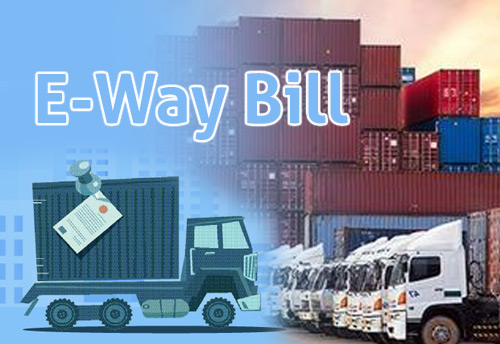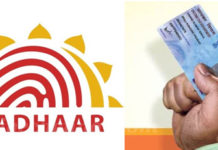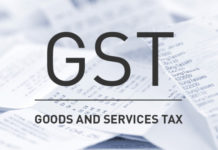Introduction
E-way bill is an electronically generated document that is required for the movement of goods from one place to another place when the value of good is more than Rs. 50,000/-. E-way bill is required to be generated in both the cases inter-state as well as intra-state.
It is required to be generated on GST portal (Common Portal).
The facility of generation, cancellation, updation and assignment of e-way bill shall be made available through SMS to the supplier, recipient and the transporter, as the case may be.
A unique e-way bill number (EBN) shall be made available to the supplier, the recipient and the transporter on the common portal after generation of e-way bill.
When should an e-way bill be generated?
E-way bill will be required to be generated when there is movement of goods value of which exceeds Rs. 50,000/-
- In relation to a supply (e.g. Sale) ; or
- for reasons other than supply (e.g. Sales return) ; or
- due to inward supply from an unregistered person
Value of consignment:
The consignment value of goods is =
Value declared in an invoice or bill of supply or a delivery challan
Add: the central tax, State or Union territory tax, integrated tax and cess charged
Less: the value of exempt supply of goods where the invoice is issued in respect of both exempt and taxable supply of goods.
Exception to the value of goods of Rs. 50000/-
In the following cases the e-way bill shall be generated by the principal irrespective of the value of the consignment:
- Where goods are sent by a principal located in one State to a job worker located in any other State,
- Where handicraft goods are transported from one State to another by a person who has been exempted from the requirement of obtaining registration.
Who is required to furnish information in E-way Bill and When?
Sr No. |
Who is required to furnish/Generate details in E –Way Bill |
When need to furnish/Generate |
GST FORM |
Part |
| 1. | Registered Person will Furnish Information | Prior to Movement of Goods | EWB-01 | Part-A |
| a) Registered Consignor/Consignee may generate (Transport by road through own vehicle or hired one or a public transport) |
Prior to Movement of Goods |
EWB-01 | Part-B
|
|
| b) Registered Consignor/Consignee may generate (Transport through railways or by air or by vessel) | Before or after the commencement of movement of Goods | EWB-01 | Part-B
|
|
| c) Registered Consignor/ Consignee will furnish information and transporter will generate e-way bill (when goods are handed over to a transporter for transport by road) | Prior to Movement of Goods | EWB-01 | Part-B
|
|
| 2. | Unregistered person causes the movement of goods either in his own conveyance or hired one or through a transporter, he or the transporter may, at their option Generate | Prior to Movement of Goods | EWB-01 | Part-A
Part-B |
| 3. | Unregistered Supplier but Registered Recipient | All Compliance to be done by Recipient as if he is the supplier ( if recipient is known at the time of commencement of movement of goods) | EWB-01 | |
| Transporter (on an authorisation received from the registered person) | Prior to Movement of Goods | EWB-01 | Part-A | |
| E-commerce operator or a Courier agency (on an authorisation received from the consignor) | Prior to Movement of Goods | EWB-01 | Part-A |
Notes:
- HSN Code in column A.6 shall be indicated at minimum two digit level for taxpayers having annual turnover upto five crore rupees in the preceding financial year and at four digit level for taxpayers having annual turnover above five crore rupees in the preceding financial year.
- Document Number may be of Tax Invoice, Bill of Supply, Delivery Challan or Bill of Entry.
- Transport Document number indicates Goods Receipt Number or Railway Receipt Number or Forwarding Note number or Parcel way bill number issued by railways or Airway Bill Number or Bill of Lading Number.
- Place of Delivery shall indicate the PIN Code of place of delivery.
- Place of dispatch shall indicate the PIN Code of place of dispatch.
- Where the supplier or the recipient is not registered, then the letters “URP” are to be filled-in in column A.1 or, as the case may be, A.3.
- Reason for Transportation shall be chosen from one of the following:
Code Description
- Supply
- Export or Import
- Job Work
- SKD or CKD
- Recipient not known
- Line Sales
- Sales Return
- Exhibition or fairs
- For own use
0. Other
The registered person or the transporter may, at his option, generate and carry the e-way bill even if the value of the consignment is less than fifty thousand rupee.
What is process while transferring goods in the course of Transit?
If any need arises for transferring of goods from one conveyance to another conveyance in the course of transit then before such transfer and further movement of goods, update the details of conveyance in the e-way bill on the common portal in FORM GST EWB-01
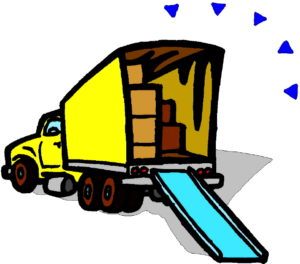
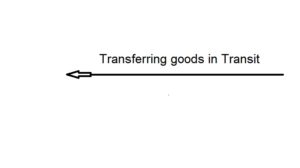
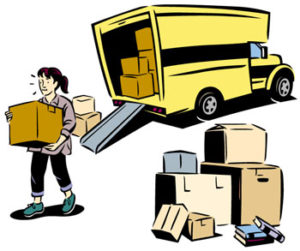
Exception to the above is where the goods are transported for a distance of less than 50 kilometres within the State or Union territory from the place of business of the transporter finally to the place of business of the consignee, the details of conveyance may not be updated in the e-way bill.
When consolidated e-way bill is required to generate?
After generation of e-way bill, where multiple consignments are intended to be transported in one conveyance, the transporter may indicate the serial number of e-way bills generated in respect of each such consignment electronically on the common portal and a consolidated e-way bill in FORM GST EWB-02 may be generated by him on the said common portal prior to the movement of goods.
If consignor or consignee has not generated E-way bill and aggregate consignment value of all consignments transported in one conveyance is more than Rs. 50000 and it is inter-statement supply then transporter (except in case of transportation of goods by railways, air and vessel ) shall generate E-way Bill in Form GST EWB-01 and may also generate consolidated E-way bill in form GST EWB-02 prior to movement of goods.
If transported through an e-commerce operator or a courier agency, the information in Part A of FORM GST EWB-01 may be furnished by such e-commerce operator or courier agency.
Communication of generation of E-way bill
The information furnished in Part A of FORM GST EWB-01 shall be made available to the registered supplier on the common portal who may utilize the same for furnishing details in FORM GSTR-1
When the information has been furnished by an unregistered supplier or unregistered recipient in FORM GST EWB-01, he shall be informed electronically, if the mobile number or the email is available.
The details of the e-way bill generated under this rule shall be made available to the-
- supplier, if registered, where the information in Part A of FORM GST EWB-01 has been furnished by the recipient or the transporter; or
2. recipient, if registered, where the information in Part A of FORM GST EWB-01 has been furnished by the supplier or the transporter,
on the common portal, and the supplier or the recipient, as the case may be, shall
communicate his acceptance or rejection of the consignment covered by the e-way bill.
The supplier or recipient, as the case may be, has to accept or reject with 72 hours of the details being made available to him on the common portal, or the time of delivery of goods whichever is earlier. If no acceptance or rejection is received in time than it shall be deemed that he has accepted the said details.
What are the circumstances under which e-way bill can be cancelled?
Goods are either not transported or are not transported as per the details furnished in the e-way bill, the e-way bill may be cancelled electronically on the common portal within 24 hours of generation of the e-way bill.
An e-way bill cannot be cancelled if it has been verified in transit in by Proper Officer.
What is validity of e-way bill generated?
For calculation of validity period two dimensions are made as follow:
- Over Dimensional Cargo
- Other than over Dimensional Cargo
An e-way bill or a consolidated e-way bill generated shall be valid for the period as mention below in the table from the relevant date:
Table
| Sr No. | Distance | Dimension | Validity period |
| (1) | (2) | (3) | (4) |
| 1. | Upto 100 km | Other than over Dimensional Cargo | One Day |
| 2. | For every 100 km or part thereof thereafter | Other than over Dimensional Cargo | One additional day |
| 3. | Upto 20km | Over Dimensional Cargo | One Day |
| 4. | For every 20 km or part thereof thereafter | Over Dimensional Cargo | One additional day |
Relevant date means the date on which the e-way bill has been generated.
Validity of the e-way bill will be counted form the time of its generation and it will expire at midnight of the day immediately following the date of generation of e-way bill.
E.g. If e-way bill is generated on 01/04/2018 at 10:00 am and the distance is 90 km than e-way bill will expire on 02/04/2018 at 12:00 am that is at midnight.
The Commissioner may extend the validity period of e-way bill for certain categories of goods.
In exceptional circumstances, if the goods cannot be transported within the validity period of the e-way bill, the transporter may generate another e-way bill after updating the details in Part B of FORM GST EWB-01.
When Part B of FORM GST EWB-01 is not required to fill:
The e-way bill shall not be valid for movement of goods by road unless the information in Part-B of FORM GST EWB-01 has been furnished except in the following cases:
Where the distance between supplier and transporter is upto 50 kms and supplier and transporter are in same state or union territory than there is no requirement to fill Part B of FORM GST EWB-01.
When e-way bill is not required to be generated?
Under following situations e-way is not required to be generated:
- Value of the goods being transported are less than Rs. 50000/- (except handicraft/ interstate jobwork)
- Goods are being transported by a non-motorised conveyance.
- Goods are being transported from the customs port, airport, air cargo complex and land customs station to an inland container depot or a container freight station for clearance by Customs.
- Movement of goods with in notified area.
- goods being transported are specified in Annexure which is as follows:
- Liquefied petroleum gas for supply to household and non domestic exempted category (NDEC) customers
- Kerosene oil sold under PDS
- Postal baggage transported by Department of Posts
- Natural or cultured pearls and precious or semi-precious stones; precious metals and metals clad with precious metal (Chapter 71)
- Jewellery, goldsmiths’ and silversmiths’ wares and other articles (Chapter 71)
- Currency
- Used personal and household effects
- Coral, unworked (0508) and worked coral (9601)
- in respect of movement of goods within such areas as are notified under clause (d) of sub-rule (14) of rule 138 of the Goods and Services Tax Rules of the concerned State.
- in respect of movement of goods within such areas as are notified under clause (d) of sub-rule (14) of rule 138 of the State or Union territory Goods and Services Tax Rules in that particular State or Union territory;
- Goods specified in notification no. 2/2017 other than De-oiled Cake.
- goods being transported are alcoholic liquor for human consumption, petroleum crude, high speed diesel, motor spirit (commonly known as petrol), natural gas or aviation turbine fuel;
- supply of goods being transported is treated as no supply under Schedule III of the Act;
- where the goods are being transported—
- under customs bond from an inland container depot or a container freight station to a customs port, airport, air cargo complex and land customs station, or from one customs station or customs port to another customs station or customs port, or
- under customs supervision or under customs seal;
- goods being transported are transit cargo from or to Nepal or Bhutan;
- exempt goods as per notification No.7/2017-Central Tax (Rate) and notification No. 26/2017- Central Tax (Rate)
- any movement of goods caused by defence formation under Ministry of defence as a consignor or consignee;
- where the consignor of goods is the Central Government, Government of any State or a local authority for transport of goods by rail;
- where empty cargo containers are being transported; and
- goods are being transported upto a distance of 20 km from the place of the business of the consignor to a weighbridge for weighment or from the weighbridge back to the place of the business of the said consignor subject to the condition that the movement of goods is accompanied by a delivery challan issued in accordance with rule 55

